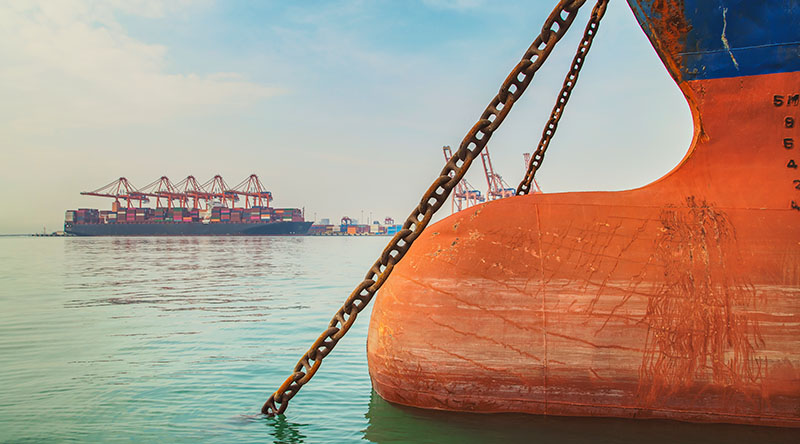The loss of an anchor may have substantial financial as well as bureaucratic consequences for shipowners. In the last months NNPC Correspondents have been requested to assist in a number of cases where an anchor (including a number of shackles of its chain) was lost due to adverse weather conditions at anchorage, as a result of which the shipowner has been requested by authorities to retrieve same.
Further to our involvement in these cases we would consider it useful to share our insights and recommendations, which we have made to P&I Clubs and their members in the process of our assistance.
Ensuring Anchoring Awareness
Dutch port and watermanagement authorities, when notified by a shipowner or coast guard, are likely to instruct lost anchors to be found and removed. This results in a “wreck removal” case for the shipowners’ P&I. We note that often the matter involves a loss of – and subsequent removal of – the anchor and sometimes part of a chain, however, more serious and costly cases occur when dragging anchors could cause damage and loss to the vessel, other vessels, property and the environment. The consequential losses of grounding and collision due to anchor dragging or loss can be significant and may consist of the following cost items (either singular or combined):
- Fines and instruction to remove anchor.
- Loss of anchor itself (financial loss).
- Grounding or collision.
- Damage to underwater cables or pipelines.
- Damage to floating objects or port facilities.
- Damage to navigation aids or facilities.
- Damage to the marine environment (e.g. pollution).
Anchoring Safety procedures
Every shipowner will have put procedures in place to ensure anchoring safety. Before each voyage this will be an inherent part of the voyage planning and as such will need to be carefully considered for each individual port call. During such assessment the following elements will need to be considered:
- Soil and nature of the seabed.
- Direction and strength of wind and current combined with limitations of ship’s anchoring equipment.
- Sea condition for the entire expected anchoring duration.
- Tidal conditions and water depth.
- Local regulations and prohibited anchoring areas.
- The safety swinging circle of the vessel: a circle with a minimum radius including length of anchor chain and the vessel’s Length Over All is recommended.
- Location of navigational aids and facilities.
- Presence and location of underwater cables and pipelines.
- Available anchoring space and other anchoring vessels in the vicinity.
A safe distance between vessels also depends on the vessel’s maneuverability that could be restored in case of anchor dragging.
The voyage planning should contain a detailed risk assessment on the basis of the above elements and should take into account emergency measures in case circumstances are not as expected. It is recommended that the voyage plan also takes into consideration alternative anchorage places in case the originally envisaged anchoring position turns out to be unsuitable/unavailable. In order to increase anchoring safety awareness it is often useful to pay attention to training crew (as well as ship operators) and to ensure that they are kept aware of the importance thereof.
What to do in case of loss of anchor and chains
When despite taking the necessary precautions the vessel does report the loss of one of its anchors (including/excluding shackles/chain). The vessel will usually report the loss of an anchor to the Dutch Coast Guard or to port authorities. Alternatively, the master of a vessel informs his agent, who will report same to the authorities.
In Dutch terms the shipowner will then typically receive a request from Dutch authorities (Rijkswaterstaat or “RWS”) to remove the anchor + chain from the seabed within a set time period. We usually see that a rather short time frame is set where the shipowner needs to indicate the measures that he intends to put in place to remove the anchor as soon as possible.
How NNPC Correspondents may assist
As local P&I Correspondents we know which marine companies and salvors are most suitable to retrieve an anchor in each specific case. We are able to select the company that can do the job against best possible rates and costs in each individual case. We coordinate matters: we know what is required by “RWS” and we instruct the selected salvor accordingly. We inform “RWS” about the progress that is being made and we discuss with them for how long a search is required in order to minimize the costs.
In order to properly instruct the salvor the following information is typically needed from the vessel in order to allow an effective search:
- Weight, dimension and particulars of the anchor and chain.
- Statement of facts of the vessel with report of the loss of anchor and exact anchoring position (latitude and longitude).
- Copy of ECDIS data/position of the vessel at the time of anchorage/loss of anchor.
- Copy of notifications received from Dutch authorities/”RWS”/Coast Guard.
When an anchor is lost, it will therefore be important for the shipowner to ensure that the above information is registered and preserved by the vessel.
We trust that the above will be useful for shipowners when considering precautionary measures to safeguard against the loss of anchors and that this may serve as guidance to shipowners as to what actions will be required from them should an anchor be lost in Dutch waters.
Contact us
We invite shipowners to contact NNPC Correspondents BV for loss prevention advice as well assistance with incident handling at correspondents@nnpc-correspondents.nl

